

Water-related Diseases. Health and Economic Impact of Unsafe Drinking Water. Australian Drinking Water Guidelines. Water-borne Viruses. Water Facts: Water. Water 1 in 10 people lack access to safe water Sanitation 1 in 3 people lack access to a toilet Women & Children.
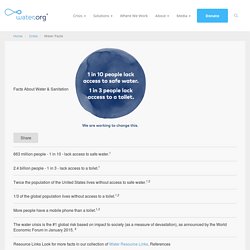
Water Brochure - WA. Improved but Not Always Safe: Despite Global Efforts, More Than 1 Billion People Likely at Risk for Lack of Clean Water. This spring the World Health Organization (WHO) celebrated the early completion the 2015 development goal of bringing improved drinking water to an additional two billion people since 1990.

"Today we recognize a great achievement for the people of the world," United Nations Secretary General Ban Ki-moon said at the occasion. "The successful efforts to provide greater access to drinking water. " The feat was a landmark in securing what the U.N. General Assembly declared in 2010 was a universal human right: "access to safe and clean water. " In an effort to improve health and quality of life across the world between 1990 and 2015, the U.N. established eight Millennium Development Goals (MDG). Water and the MDG'S. Water, Sanitation and the Millennium Development Goals: A Report Card on Global Progress. Graphic from UN Millennium Development Goals and Beyond 2015 website In 2000, the United Nations adopted a set of eight Millennium Development Goals (MDGs) to improve the lives of the poorest people on Earth.
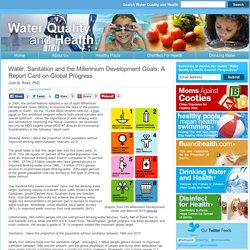
As the 15-year MDG timeline runs out, a final report on this ambitious program reflects both mixed success and overall optimism. How to Clean Untreated Water. 5 Water Storage Tips Everyone Should Know. Please note this article is about water storage tips.
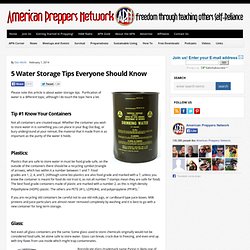
Purification of water is a different topic, although I do touch the topic here a bit. Tip #1 Know Your Containers Not all containers are created equal. Whether the container you wish to store water in is something you can place in your Bug Out Bag, or bury underground at your retreat, the material that it made from is as important as the purity of the water it holds. These are the Australian towns where the tap water's toxic - 23/04/2015.
These are the Australian towns where the tap water's toxic Australian Broadcasting Corporation Broadcast: 23/04/2015 Reporter: Michael Atkin Water in five Tasmanian towns is unfit to drink and in 22 more it has to be boiled, so what is the cause of the lead contamination and how are locals finding solutions to their toxic drinking water supply.
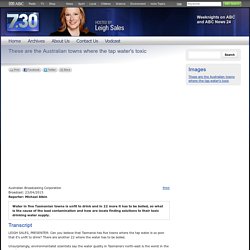
Transcript. Safe Drinking Water is Essential - Millennium Development Goals. Millennium Development Goals The United Nation’s Millennium Development Goals were created to dramatically improve the lives of the world’s poorest.
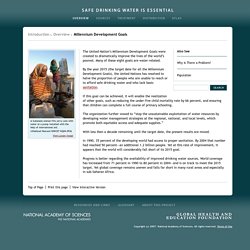
Many of these eight goals are water-related. By the year 2015 (the target date for all the Millennium Development Goals), the United Nations has resolved to halve the proportion of people who are unable to reach or to afford safe drinking water and who lack basic sanitation. If this goal can be achieved, it will enable the realization of other goals, such as reducing the under-five child mortality rate by 66 percent, and ensuring that children can complete a full course of primary schooling. Millennium Development Goal target on drinking water met. Lenny Kravitz supports UNICEF’s efforts to expand access to safe water and sanitation By Rebecca Zerzan NEW YORK, USA, 6 March 2012 – The world has met the Millennium Development Goal (MDG) target of halving the proportion of people without access to safe drinking water, well ahead of the MDG 2015 deadline.
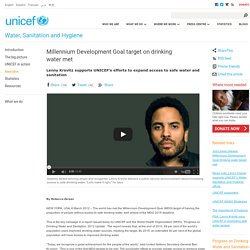
This is the key message in a report issued today by UNICEF and the World Health Organization (WHO), ‘Progress on Drinking Water and Sanitation, 2012 Update’. The report reveals that, at the end of 2010, 89 per cent of the world’s population used improved drinking water sources, meeting the target. Water Wise - Unsafe Water and Hygiene. How many may be are at risk?
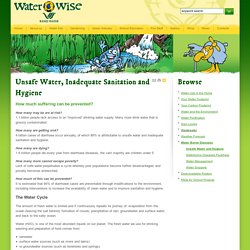
1,1 billion people lack access to an “improved” drinking water supply. Many more drink water that is grossly contaminated. Legislation: Water - Department of Health and Human Services, Victoria, Australia. Safe Drinking Water Act 2003 The Victorian Government passed new legislation, the Safe Drinking Water Act, in June 2003.
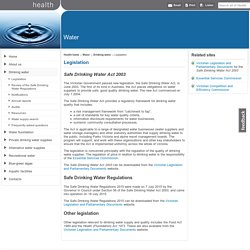
The first of its kind in Australia, the Act places obligations on water suppliers to provide safe, good quality drinking water. Drinking water. Water safe for consumption Drinking water, also known as potable water, is water that is safe to drink or to use for food preparation.
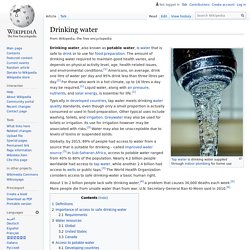
The amount of drinking water required to maintain good health varies, and depends on physical activity level, age, health-related issues, and environmental conditions.[1] Americans, on average, drink one litre of water per day and 95% drink less than three litres per day.[2] For those who work in a hot climate, up to 16 litres a day may be required.[1] Liquid water, along with air pressure, nutrients, and solar energy, is essential for life.[1] Typically in developed countries, tap water meets drinking water quality standards, even though only a small proportion is actually consumed or used in food preparation. Other typical uses include washing, toilets, and irrigation. Greywater may also be used for toilets or irrigation. Review of the Safe Drinking Water Regulations: Water - Department of Health and Human Services, Victoria, Australia. The Department of Health & Human Services commenced a review in 2012 to consider the future of the Safe Drinking Water framework.
This review has considered the best available scientific evidence on drinking water and opportunities to reduce regulatory burden without compromising the safety of Victoria’s drinking water. Notice of Decision The Minister for Health has recommended the proposed Safe Drinking Water Regulations 2015 be made with the following amendments: Millions More Get Clean Water, But Sanitation Lags. Is Your Drinking Water Safe? Thursday, August 20, 2015 Originally published on Healthy Child Healthy World by Megan Boyle. How many times a day do you drink water? What's actually in a glass of water? Is your water really clean? Nikki* woke up crying with a sharp pain in her abdomen. The next few days, her health deteriorated even more as she experienced bloody diarrhea, nausea, loss of appetite and fever. A trip to the doctor confirmed that she had amoebiasis, a type of stomach flu caused by a parasite.
In more serious cases, this disease could even spread to the liver, lungs and the brain. The surprising culprit behind this illness? Water refills from refilling stations that do not meet high quality standards for potable drinking water. 5 Essential Steps to Clean Water for Everyone According to data from the Beverage Marketing Corporation (a market research firm), bottled water will outsell soda in America in approximately two years. I can hear the sound of environmentalists shrieking ("Just drink tap! "), health proponents clapping ("Finally, people are choosing water over sugary drinks! "), and giant water companies quietly panicking ("Oh, crap! Millions More Get Clean Water, But Sanitation Lags. Showing 1-20 of 26632 videos in News/World Austria: Hundreds of child refugees cross border Hundreds of refugees, predominantly Syrian and Afghani, arrived at the Austrian border town of Nickelsdorf where they got provided for at the Nova Rock music festival camp area, Sunday.
Water, Sanitation and Water-Borne Diseases. United Nations Millennium Development Goals. What's REALLY in Our Drinking Water? United Nations Global Issues. 1 billion people have no access to clean drinking water. Clean water. About Water, Clean Drinking Water Treatment Removes Water Pollution. The countries around the world that have safe drinking water. Drinking water quality - Melbourne Water. Recreational Access to Drinking Water.
Drinking Water Contaminants. Tests reveal concerning lead levels in drinking water. Consequences of Unsafe Drinking Water. WHO- Health through safe drinking water and basic sanitation.